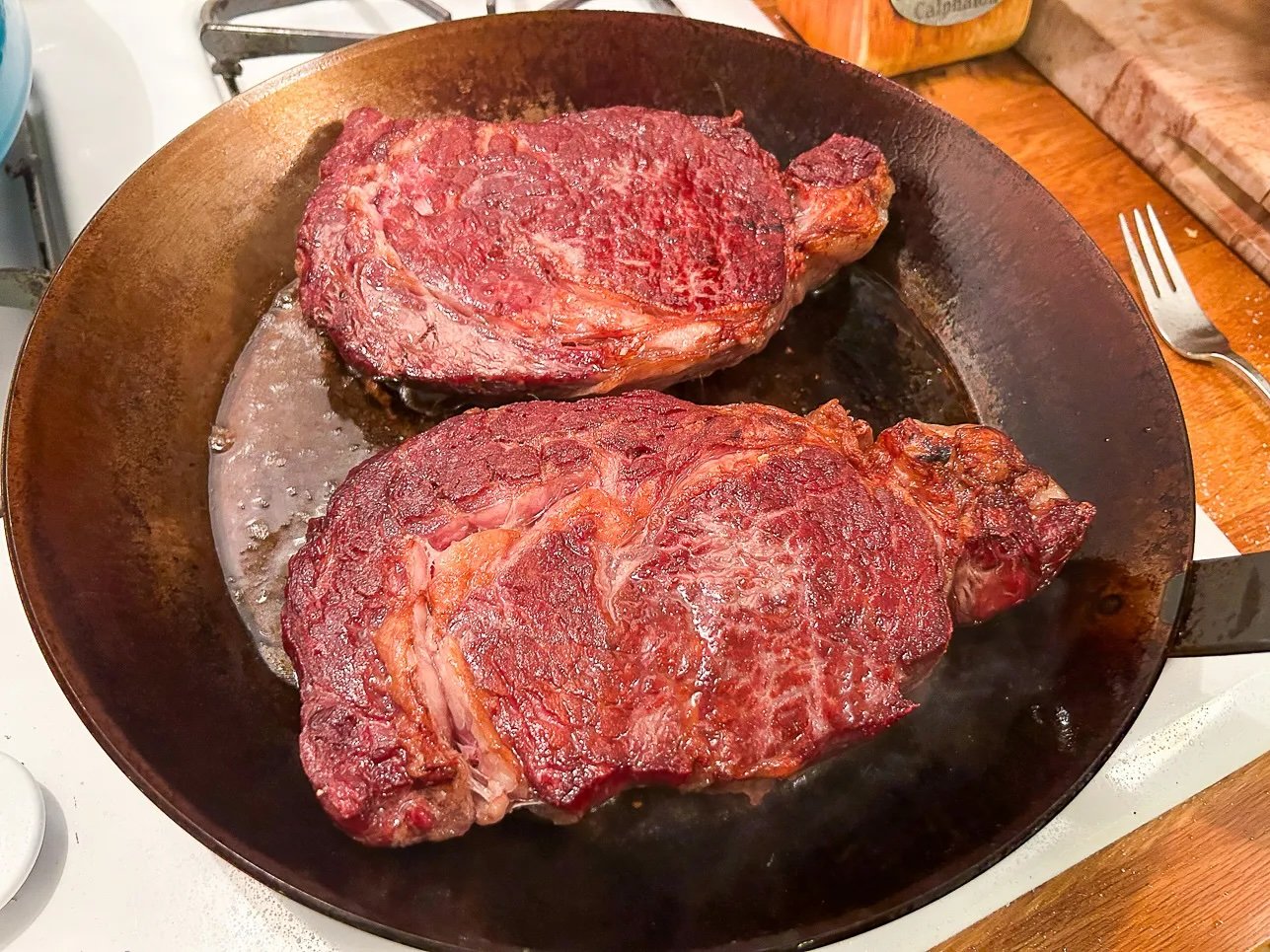Reverse-Seared Ribeyes
Remember that scene in Mary Poppins where they all go up the chimney and come out all sooty? That's what my dinner guests usually look like when I cook steak. The whole kitchen fills up with black clouds as I sear the meat in a large cast-iron skillet, flipping and continuing to cook while frantically taking the temperature to make sure I stop in time to hit medium-rare. Sometimes I get it right on the first go; other times, I serve the steak and somebody politely says: "Ummm, sorry, but is it supposed to be blue inside?" That all changed this past Saturday when I cooked my usual steakhouse dinner for our friends Marcos and John, only this time the kitchen wasn't full of smoke and the steaks came out absolutely perfect. The secret? Reverse-seared ribeyes.
The Easiest Steak Cookery You Will Ever Do
Do you see the image above? That's the extent of what you have to do to reverse sear. There's no stock pot where you mimic a sous vide, no vacuum sealer that you have to pack the meat into. You just line a sheet pan with foil (you don't even need to do that, it just makes clean up easier), place a rack on top, and then place two ribeyes on top. They should be at least an inch thick -- these were about 1.4". Season all over with salt and pepper (be generous... that's a lot of meat to season). Then wait for them to come to room temperature, about 30 minutes.
Preheat the oven to 250 and then insert your sheet tray and cook for 20 to 25 minutes until a thermometer reads 115 (that's for medium rare, which is what you want) when inserted into the thickest parts of the steak. That's it. To reiterate: put meat on a rack, season the meat, put it in a 250 oven, cook 25 minutes until it's 115 in the thickest parts. Now you just have to sear it.
Searing the Reverse-Sear Ribeyes
For this step, get out your largest cast iron skillet or carbon steel skillet (that's what I have here) and heat on high heat until super hot. Add a splash of vegetable oil and then lay in your ribeyes directly from the oven. They should immediately sizzle.
Your goal here is just to get color on the outside. The steaks are basically cooked; you just want to cook on one side until golden, flip, and then keep cooking until you get to an internal temperature of 130 for medium-rare (140 for medium). Once that happens, you immediately remove the steak and slice into it, against the grain. No need to rest it!
Look at that color. Can you even? Ribeye doesn't get much better than that!
Serving Up Your Ribeyes
I like to make a green salsa verde / chimichurri kind of thing by chopping a bunch of parsley, two cloves of garlic, and some pickled red chilies until very very finely minced. Then I stir that together with lemon zest, lemon juice, and enough olive oil to make a thick paste.
To serve up the steaks, I lifted some slices on to each plate and then topped each portion with the green sauce.
As for the other stuff: that's a little gem salad with homemade Roquefort dressing and roasted fingerling potatoes with Parmesan. Our dinner guests were very happy indeed!
Now that I've reverse-seared ribeyes, I'm never looking back. No more clouds of smoke, no more questionable doneness. Chim-chiminee indeed.
Reverse-Seared Ribeyes
A technique for getting perfectly cooked ribeye steaks every time.
For the ribeyes:
2 large ribeyes, around 1 pound each, at least 1" thick
Kosher salt
Freshly ground black pepper
For the green herb sauce:
1 bunch Italian flat-leaf parsley
2 cloves garlic, peeled and sliced
2 pickled red chilies or one fresh red chili
1 lemon
1/2 cup extra-virgin olive oil
To finish the steaks:
Vegetable oil
Preheat the oven to 250. Place a wire rack on top of a foil-lined cookie sheet. Place the ribeyes on top, pat dry with paper towels, then season generously with kosher salt and pepper (rain it down like a chef!). Let sit for 20 to 30 minutes to come to room temperature.
Insert the sheet pan into the oven and cook for 20 to 25 minutes until a thermometer inserted into the thickest part reads 115 for medium-rare (for medium, shoot for 125).
While the steaks are cooking, make your green sauce. Roughly scrape the leaves off the parsley stems (it's okay if a few stems get in there). Lay them on a cutting board and place the garlic and chilies on top. Using your sharpest knife chop chop chop and keep chopping -- it'll take a few minutes -- until everything is finely minced. Add the mixture to a bowl and zest the lemon over it, add the lemon juice, add a pinch of salt, and then stir in the olive oil until it's pasty but not so thick it won't spill off a spoon. Set aside.
When the ribeyes reach the right temperature, heat a large cast iron skillet or carbon steel skillet on high heat until you can't hold your hand near it without it getting too hot, then add a splash of vegetable oil. Lay in your ribeyes straight from the oven and let them sear on the first side without moving them for 30 seconds to a minute. When they detach easily and are golden brown, flip them over and finish on the second side until a thermometer reads 130 for medium-rare and/or 140 for medium.
Immediately slice the ribeyes against the grain, place on to a platter, and spoon the sauce on top. Serve right away.








